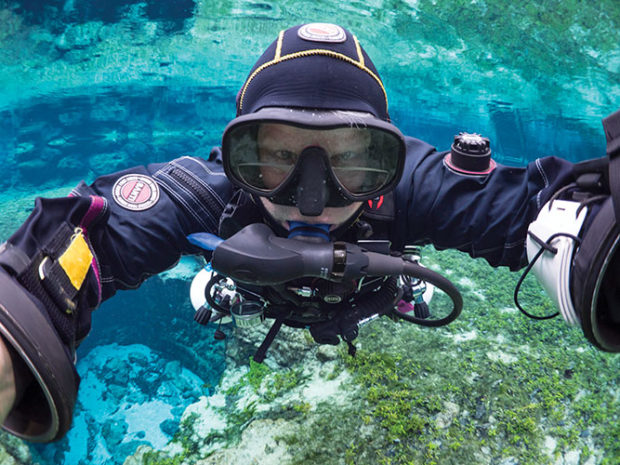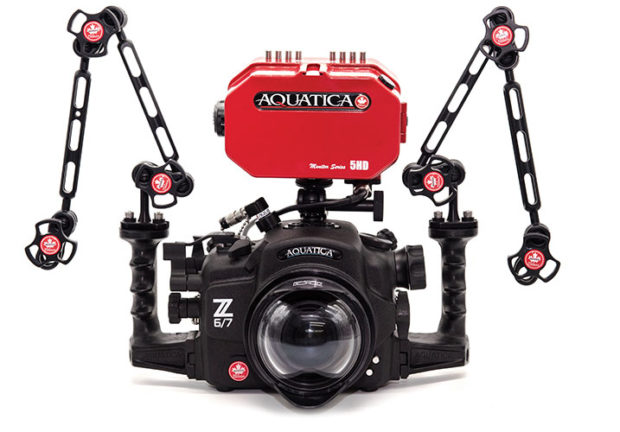Blind as a Bat Fish
By Jill Heinerth

If you are over forty years of age, you are probably getting to the point where it is tough to read your computer display or SPG. For many people approaching this age, the lenses of your eyes start to lose elasticity and flexibility. With less elasticity, the eye may be unable to focus sharply on close objects. As it turns out, a significant percentage of the diving public falls into the “older” category demographics, myself included. You might have already purchased topside reading glasses, but what about diving? At some point, the natural magnification produced by water is not going to be enough. It started with my gauges, and then one day, I realized I could barely read the exposure information in my camera’s viewfinder. Fortunately, there are many options available to help us middle agers stay in the game.
Camera Diopter
If you are using a viewfinder, most DSLR and mirrorless cameras have a diopter wheel placed near the viewfinder. If you are under forty, you have never likely never noticed it! Look into the viewfinder and spin the wheel until the exposure information at the bottom of the frame is clear. If you pass the camera to someone else, it will appear blurry for them unless they have the same prescription. This adjustment only corrects the viewfinder and not the LCD.
Stick On Lenses
I began fighting my descent into farsightedness by adding a small round stick-on lens in the lower left corner of my mask. The removable spot provided sharpness for reading a wrist mounted dive computer and SPG, but things got worse. I picked up a similar product that was available in moon shaped pairs. These lenses came with a waterproof glue that adhered to the mask permanently.
Bifocal Readers
Most manufacturers carry at least one model of a two-window mask with replacement lenses. The lenses may be purchased in left and right bifocal prescriptions with clear glass on the top and magnification on the bottom. They are generally available up to 2.5+ magnification. The lenses are snapped in place by the user and swapped out if the prescription changes over time.

Focus Assist or Peaking
When it comes to focus, autofocus is not always possible or even the best solution in some circumstances. Professional video cameras often don’t have the option. Even with autofocus, you’ve probably shot a few sequences with the autofocus tracking something other than your subject. The need for manual focus is inevitable. A feature called focus peaking is becoming more common in DSLRs and Mirrorless cameras. The feature works by detecting the edges of things in your scene. If the edges are in focus, they are highlighted in a bright colour of your choice. I choose a contrasting, warm colour like orange or red, so it stands out in my otherwise blue palette underwater. When your lens is stopped down, it will show you how much of your frame is in focus, helping you make the right depth of field choices. This feature is only available through the live-view function of your LCD, electronic viewfinder, or monitor. You will not get this feature in a rangefinder or optical viewfinder. An external monitor usually has a separate peaking function which enhances the capability significantly.
Custom Prescription Bifocal Inserts
If you have a vision issue affecting both your near and far vision, you might need a full prescription. Many opticians can cut a custom prescription bifocal and adhere it to the interior of a mask, but frankly, it will look ghastly. Peripheral vision is diminished since the lenses rarely come close to the mask edges.
Custom Prescription Bifocal Mask
PrescriptionDiveMasks.com will cut a custom replacement lens for any mask that you send them. Brace yourself for the expense. It is similar to a good pair of bifocal glasses. That said, it is the cleanest solution. Before mailing your mask to them, put it on and mark the lens with a piece of tape indicating the height of the reader. If you are a videographer, you probably want the height higher than a regular diver. Look into your viewfinder or monitor to make the determination. Standard heights tend to be too low since you are looking down into the display. I often wish I could get upside-down readers for this reason.
Wire Frame Inserts
Some full face masks are equipped with the facility to clip in a wire frame that holds your prescription glasses. You simply remove the arms and clip them in place.
Contact Lenses
Some divers wear one contact lens for near and one for far vision, but depending on your prescription, you might not be a good candidate for this solution. Many opticians will not recommend using contacts for diving. It is not just a matter of losing a lens. Contact lenses are notorious for trapping bacteria, and even the best diver will have some exposure to water and body fluids inside a mask.
Surgery
LASIK surgery typically helps people with distance vision issues rather than trouble with reading. Typical LASIK patients still wear reading glasses after surgery. Presbyopia or farsightedness is inevitable for everyone as a result
of aging. Sorry.

Monitor
A camera monitor offers an enhanced and enlarged view that makes shooting video easier. It might seem like a significant investment, but monitors can usually transfer from one system to the next, providing a solution that transcends camera upgrades.
Zoom In
Many cameras offer a shortcut button that permits zooming in to check focus. This feature can be convenient if you are working from an electronic viewfinder that is small.
At the ripe young age of 53, I keep looking for better solutions to the challenges of my deteriorating eyesight. I’ve been through several magnifications over the years and hope that I have finally leveled off. With a bit of assistive high technology, I guess I’m proof that even a visually challenged camera operator can still create magic!
One Response to “Blind as a Bat Fish”
Leave a Comment








Sergio Mazzarella
Hello All,
I just read this article.
It mentions in “Stick on Lenses” section :
“…I picked up a similar product that was available in moon shaped pairs. These lenses came with a waterproof glue that adhered to the mask permanently. …”
May I ask you to post the brand, details and website of the product ?
Many thanks.
Kind regards,
Sergio